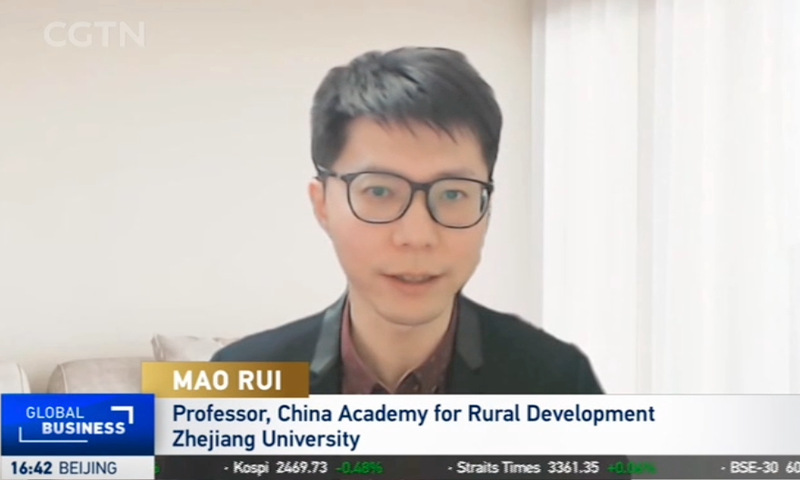2023年2月10日,浙江大学公共管理学院茅锐教授受邀做客中国国际电视台(CGTN)《全球财经》(Global Business)栏目,就中国在全球通胀快速上行背景下维持粮食价格稳定和保障粮食安全等问题做了解答。
茅锐指出,2022年我国CPI同比上升2%,食品价格指数上涨2.8%,较2021年有所扩大,但明显低于FAO全球食品价格指数14.3%的增幅。这与我国采取的一系列稳粮价政策密不可分。在进口端,我国采取了玉米豆粕减量替代方案、扩大了碎米进口、并且首次从巴西进口玉米以补足饲用粮缺口。在生产端,我国实施了大豆油料产能提升工程,并大力推广大豆玉米带状复合种植技术。在流通端,我国建立了有效的粮食储备、分配和应急体系,粮食跨省流通能力不断增强。以下是主要采访内容(播出时节选)。

China adopted a number of efficient and effective measures to maintain the grain and food prices stable. To tackle import risks brought by a series of geopolitical tensions and extreme weather last year, China launched a reduction and substitution campaign for corn and soymeal – the two most important grain imports – to reduce the import demand for animal feed. Thanks to that, the quantity of grain imports declined by about 11%. China also sought alternative import sources. It imported 1.2 million tonnes of corn from Brazil, which was the first time of corn imports from there and accounted for roughly 15% of corn imports from Ukraine in 2021. It has also increased rice imports, primarily broken rice for animal feed, by more than 30%, which also for the first time exceeded China’s import limit quota. This provided an important substitute for corn as the global maize price rose by 25% last year.
The government has also provided specific subsidies to encourage the companion planting of corn and soybeans, which could increase soybean yield while ensuring a steady output of corn. Actually, 2022 was the first year for China to promote a large-scale implementation of this planting mode.
Aside from stabilizing imports and production, China established a forceful and efficient grain stock and distribution system. China's domestic grain purchases last year are expected to reach 400 billion kilograms, keeping in line with the level we see in previous years. Relying on the bones and bloods of infrastructure through roads, rails and water, and thanks to response plans to grain emergencies made by all levels of government, China’s capacity for inter-province reallocation of grain has already reached 250 million tonnes.
乡村振兴培训、社会治理培训、城市管理培训、履职能力培训、应急管理培训、社会保障系统培训、高校培训、两新培训、生态文明培训、市场监督培训、纪检监察培训、农业农村培训、创新创业培训、非公企业、高校改革培训、三农培训、自然资源培训、县域经济培训、国土培训、长三角一体化、城乡协调发展、碳达峰碳中和、大数据、民营经济培训、医保培训、社保培训、国土空间培训、军人事务培训、能源培训等。
涉及培训系统有:
司法系统、教育系统、公安系统、财政系统、检察院、档案系统、工商联、卫健委、宣传系统、城管局、审计系统、档案系统、民宗委、人社局、管委会、编办系统、协会、网信办、文广旅游局、住建系统、卫健系统、医疗系统、金融系统、银行系统培训、城市管理、财税系统、地铁系统、电力系统等。



